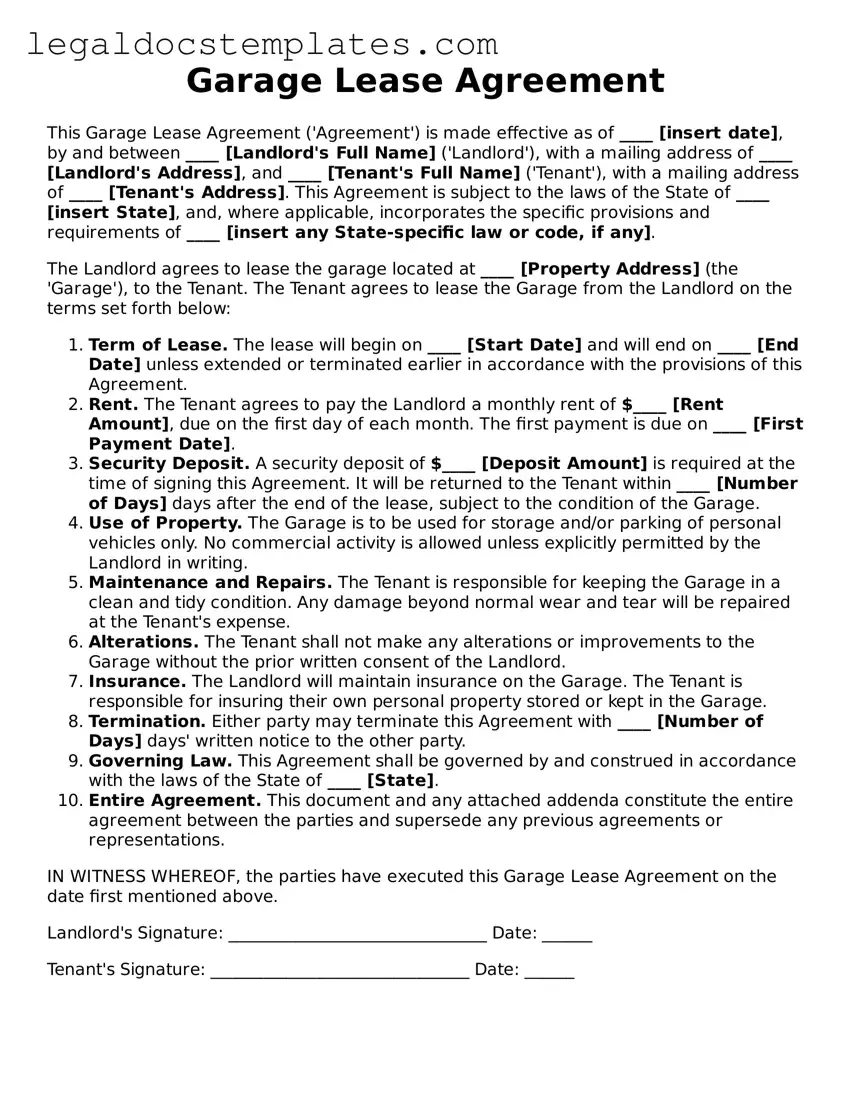A Residential Lease Agreement is notably similar to a Garage Lease Agreement in that both establish a rental relationship between a landlord and a tenant. While the former typically pertains to living spaces such as apartments and houses, the latter focuses solely on the rental of a garage space. Both documents outline terms including the duration of the lease, rental payment details, security deposit information, and the rights and obligations of each party. They are crucial in creating clear expectations and legal boundaries for the use of the rented property.
A Commercial Lease Agreement shares similarities with a Garage Lease Agreement in that it is used for renting out spaces. However, a Commercial Lease Agreement is designed specifically for business-related properties like offices, retail spaces, or warehouses, contrasting with a garage space's more straightforward storage or vehicle parking use. Despite their primary purposes differing, both include terms related to lease duration, payment schedules, maintenance responsibilities, and other conditions necessary to protect the interests of both the property owner and the lessee.
A Storage Unit Lease Agreement is very similar to a Garage Lease Agreement as both are designed for the purpose of renting space to store property. The main difference lies in the specificity of space; storage units often refer to units within a larger facility, while garage spaces can be standalone or part of a residential property. Both agreements clearly define the lease term, rent detail, the security measures expected, and guidelines for what can and cannot be stored, ensuring that the property is used appropriately and maintained properly.
A Parking Space Lease Agreement is closely related to a Garage Lease Agreement, with both dedicated to the leasing of a space for a vehicle. The key distinction is that Parking Space Lease Agreements may apply to open, uncovered spaces or covered parking lots, unlike the enclosed, private nature of a garage. These agreements typically specify the location of the parking space, lease term, payment amount, and any rules regarding the use of the space, such as hours of access and vehicle size restrictions.
A Sublease Agreement, while generally used for subletting residential or commercial properties, bears resemblance to a Garage Lease Agreement in the concept of re-renting. In a Sublease Agreement, the original tenant becomes the sublessor, renting out their leased space to a subtenant. This can also apply to a garage space if permitted by the original lease. Both documents must detail the lease’s duration, payment terms, and conditions of use, ensuring that subleasing activities are conducted within the scope of the primary lease agreement.
A Rent to Own Lease Agreement offers a unique blend of rental and purchase options, unlike the purely rental nature of a Garage Lease Agreement. However, they share the foundational structure of stipulating terms regarding the use of a property. In a rent-to-own scenario for homes or other properties, the agreement includes provisions for rental payments, with an additional option for the tenant to purchase the property outright at a predetermined point. Both types of agreements include similar clauses about lease terms, maintenance responsibilities, and payments to ensure a clear understanding of each party’s obligations.
A Vacation Rental Agreement is used for short-term rentals of furnished properties, such as houses or apartments, contrasting with the typically longer-term or specific use case of a Garage Lease Agreement. However, they are alike in that they both outline the terms of a temporary occupancy, detailing payments, security deposits, rules of conduct, and the responsibilities of both the renter and the property owner. This ensures that both parties are protected during the term of the occupancy.
An Equipment Lease Agreement, while focusing on the rental of machinery or equipment rather than property space, shares the contractual essence with a Garage Lease Agreement. Both agreements serve to formalize the terms under which one party agrees to rent an asset owned by another party. They specify the rental period, payment terms, maintenance obligations, and liability issues. This ensures that the asset, whether it’s equipment or garage space, is used responsibly and returned in good condition.
